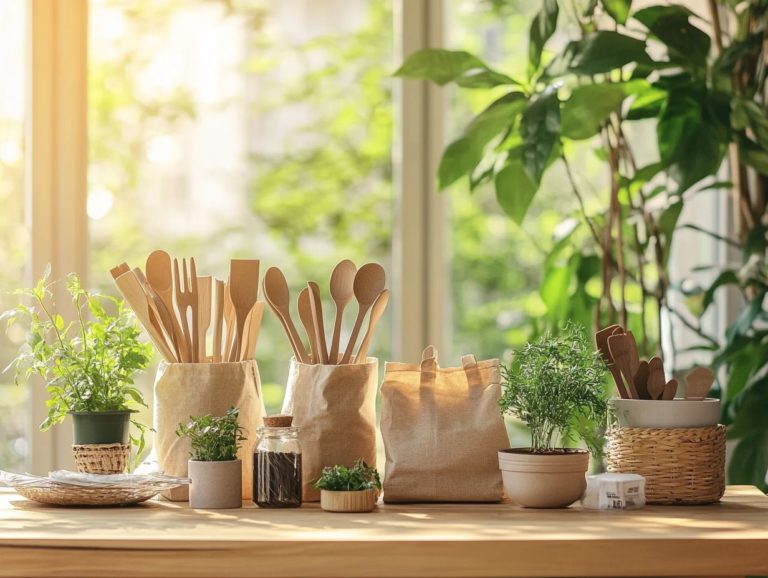Why Glass is a Sustainable Material Choice
Glass often flies under the radar in conversations about sustainable materials. Its environmental benefits are significant and multifaceted.
Let s dive into why glass is a fantastic choice compared to other materials. This exploration emphasizes its recyclability and energy efficiency. It also investigates its crucial role in sustainable architecture, innovations that minimize carbon emissions during production, and practical tips for weaving glass into your eco-friendly practices.
By the end of this journey, you’ll appreciate how choosing glass can play an important role in fostering a more sustainable future.
Contents
- Key Takeaways:
- The Environmental Impact of Glass
- Advantages of Glass as a Sustainable Material
- The Role of Glass in Sustainable Architecture
- Innovations in Sustainable Glass Production
- Practical Tips for Using Glass Sustainably
- Frequently Asked Questions
- What makes glass a sustainable material choice?
- How does glass production impact the environment?
- Can glass be recycled indefinitely?
- What are the benefits of using glass in construction?
- Does using glass help reduce landfill waste?
- Are there any downsides to using glass as a sustainable material choice?
Key Takeaways:

- Glass is a sustainable material choice with minimal environmental impact.
- It’s highly recyclable and reusable, making it perfect for eco-friendly design.
- Innovations in production are cutting down carbon emissions and waste.
The Environmental Impact of Glass
The environmental impact of glass is a vital subject in today s discourse on sustainability and responsible consumption. It underscores the importance of eco-friendly materials and sustainable practices.
Glass, as a recyclable material, plays an important role in tackling environmental challenges. By reducing dependence on raw materials, minimizing carbon emissions, and enhancing energy efficiency during recycling, glass proves itself invaluable.
Using recyclable glass aids in waste reduction and fosters a closed-loop system, perfectly aligning with the principles of a circular economy a system where products can be reused and recycled, minimizing waste for the benefit of generations to come.
Comparison to Other Materials
When comparing glass to other materials, it s essential to examine the sustainability and environmental impact of each, particularly regarding packaging solutions and recycling processes.
While plastic often gets praise for its lightweight nature and versatility, it falls short in recyclability and long-term sustainability. Research indicates that a mere 9% of plastic ever produced has been recycled, leading to a staggering accumulation of waste in landfills and oceans.
On the flip side, glass shines as a recycling champion, capable of being recycled indefinitely without compromising quality. In fact, nearly 30% of new glass containers are made from recycled materials. Moreover, glass production boasts lower carbon emissions compared to metal, requiring less energy and fewer resources throughout its lifecycle.
According to a report from the Glass Packaging Institute, utilizing recycled glass can save up to 30% in energy costs. This makes glass not just a sustainable option, but also an efficient one, positioning it as a superior alternative to both plastic and metal in the pursuit of environmentally responsible packaging.
Advantages of Glass as a Sustainable Material
Glass stands out as a premier sustainable material, offering a host of advantages that make it an exceptional choice for anyone committed to eco-friendly practices.
Its recyclability, energy efficiency, and environmentally friendly properties position glass as an ideal option for those who prioritize sustainability in packaging and product design.
Recyclability and Reusability
The recyclability and reusability of glass are crucial for reducing waste and encouraging eco-conscious choices among consumers like you. This material can be endlessly recycled without sacrificing quality, which is nothing short of remarkable.
By ensuring that glass waste is kept out of landfills, you help foster a sustainable production cycle where recycled materials are transformed back into new glass products, effectively creating a closed loop.
When you participate in this recycling process, you play a vital role in a circular economy that emphasizes resource conservation and environmental stewardship. Upcycling initiatives take it a step further by sparking creativity; discarded glass containers can be transformed into exquisite home d cor, functional storage solutions, or even innovative garden planters.
Consider simple DIY projects, such as turning jars into elegant candle holders or stylish desk organizers. These not only infuse your living space with a personal touch but also inspire others to embrace sustainable practices in their daily lives.
Choosing glass today can help safeguard our planet for future generations!
Energy Efficiency

Energy efficiency plays a pivotal role in the environmental impact of glass manufacturing. By utilizing renewable resources, you can significantly reduce carbon emissions.
This is especially relevant as the industry adopts innovative technologies and navigates stricter environmental policies. For example, a leading glass manufacturer adopted a new furnace system that harnesses waste heat. This innovation achieved a remarkable 30% reduction in energy consumption.
Another noteworthy instance involves a company that invested in solar energy to power its operations. This showcases how renewable sources can diminish reliance on fossil fuels.
These case studies illustrate that prioritizing energy efficiency boosts operational effectiveness and aligns with global sustainability objectives. You help the planet and boost your business’s success.
The Role of Glass in Sustainable Architecture
In sustainable architecture, glass products are game-changers! They elevate the aesthetic appeal of structures and provide functional benefits, including improved energy efficiency.
Design and Construction Considerations
Designing with glass is crucial for maximizing energy efficiency and minimizing environmental impact. It also elevates the visual appeal of your spaces.
Using glass allows you to craft striking aesthetics while maintaining structural integrity. Modern glazing technology has improved insulation properties significantly, enabling you to create expansive, well-lit areas that reduce reliance on artificial lighting.
This blend of functionality and beauty makes glass an incredibly versatile choice for contemporary projects. Innovations like low-emissivity coatings special coatings that help keep heat inside buildings enhance thermal performance.
Eco-friendly options such as recycled glass or solar glass contribute to your sustainability goals. Consider notable examples like Moshe Safdie’s work, which shows how glass elegantly integrates into various environments, promoting a harmonious relationship between nature and architecture.
Innovations in Sustainable Glass Production
Innovations in sustainable glass production are essential for reducing carbon emissions and enhancing energy efficiency. Manufacturers are embracing renewable resources and cutting-edge recycling technologies.
Expect significant progress in creating a more eco-friendly glass industry. Innovations like electric melting furnaces and improved batch processing techniques minimize energy consumption and allow for utilizing renewable energy sources.
For instance, a leading glass manufacturer showcased a remarkable 30% reduction in emissions after integrating a solar energy system into their operations. Recycling initiatives, where cullet (recycled glass) is incorporated into production, drastically reduce the amount of raw materials needed, cutting down waste and emissions.
By adopting these strategic measures, you can contribute to the glass industry s notable strides toward sustainability. Join us in leading the change towards sustainable glass production!
Practical Tips for Using Glass Sustainably

Living sustainably with glass requires practical strategies for proper disposal, understanding the recycling process, and selecting eco-friendly glass products that contribute to waste reduction and resource conservation.
Choosing glass is a powerful step towards a greener future.
Proper Disposal and Recycling
Proper disposal and recycling of glass are essential for effective waste management. This allows glass to seamlessly reenter the production cycle as recyclable material.
This practice conserves natural resources and minimizes environmental impact, making it imperative for communities to prioritize these efforts.
You can make a difference by actively participating in local recycling programs, which often feature designated bins for glass collection and may include convenient drop-off locations for proper disposal.
Engaging in these initiatives benefits the planet by reducing landfill waste and promotes your health, as reusing glass diminishes the need for new materials that could pose health risks during production.
By embracing these best practices, you can play a pivotal role in fostering a sustainable and healthier environment for all.
Choosing Eco-Friendly Glass Products
Choosing eco-friendly glass products is essential for adopting sustainable practices and contributing to a healthier environment and consumer well-being.
In recent years, more consumers have recognized the importance of making environmentally conscious choices, especially regarding everyday items like drinkware and storage containers. By opting for glass products from brands that prioritize sustainability, you can significantly reduce plastic waste and minimize your carbon footprint.
If you want to make a positive impact, consider brands like Bormioli Rocco, Ball, and Lifefactory, renowned for their commitment to eco-friendly production methods.
These companies utilize recycled materials and focus on crafting durable goods that support a zero-waste lifestyle, which is a way of living that aims to send no waste to landfills. This proves that style and sustainability can effortlessly coexist.
Frequently Asked Questions
What makes glass a sustainable material choice?
Glass is sustainable because it is made from abundant natural resources like sand, soda ash, and limestone, which are readily available and do not harm the environment when extracted.
How does glass production impact the environment?

Glass production has a relatively low impact on the environment compared to other materials. It requires less energy and resources to produce, resulting in lower greenhouse gas emissions and reduced waste.
Can glass be recycled indefinitely?
Absolutely! Glass can be recycled endlessly without losing quality. This means it can be melted down and reshaped into new products without the need for new materials, reducing the demand for natural resources and lowering carbon emissions.
What are the benefits of using glass in construction?
Glass is a sustainable choice for construction because it allows natural light to enter buildings, reducing the need for artificial lighting and decreasing energy consumption. It also has high thermal performance, helping to regulate temperature and reduce the need for heating and cooling.
Does using glass help reduce landfill waste?
Yes, using glass helps to reduce landfill waste. When glass is recycled, it diverts waste from landfills and conserves natural resources. It also reduces the amount of energy and resources needed to create new products, further benefiting the environment.
Are there any downsides to using glass as a sustainable material choice?
While glass has many sustainable benefits, it can be fragile and may require more care in handling and maintenance compared to other materials. Additionally, the transportation of glass can contribute to carbon emissions, so it is important to consider the sourcing and location of glass products.






